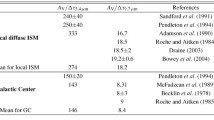Abstract
Two broad emission features often observed in the infrared spectra of cool stars near 10 and 18 µm are commonly attributed to thermal radiation by silicate dust grains1. This identification is suggested by laboratory analyses of silicate minerals, which indicate strong lattice vibrations resulting from Si–O stretching modes (in the 10-µm region) and Si–O‐Si bending modes (near 18 µm). For luminous sources shining through cold, intervening dust clouds which contain silicates, it is expected that both the stretching and bending bands should be observable in absorption (for sufficiently large column densities of dust). The infrared spectrum of the Galactic centre shows a deep absorption feature at 10 µm (N. J. Woolf, unpublished) and evidence for absorption at 18 µm (ref. 2). Strong 10-µm absorption is also observed for the Orion point source ‘BN’ (ref. 3), IRS5/W3 (ref. 4), and AFCRL809–2992 (ref. 5); no data demonstrating the presence of 18-µm absorption for these sources at longer wavelengths have yet appeared. We report here the detection of 18-µm absorption features in the spectra of AFCRL809–2992 and an infrared object associated with the microwave source OH 26.5+0.6 (ref. 6). We attribute these features to the Si–O–Si bending mode in silicates.
Similar content being viewed by others
References
Ney, E. P., Publs astr. Soc. Pacif., 84, 613–618 (1972).
Low, F. J., Kleinmann, D. E., Forbes, F. F., and Aumann, H. H., Astrophys. J. Lett., 157, L97–L101 (1969).
Gillett, F. C., and Forrest, W. J., Astrophys. J., 179, 483–491 (1973).
Aitken, D. K., and Jones, B., Astrophys. J., 184, 127–133 (1973).
Merrill, K. M., and Soifer, B. T., Astrophys. J. Lett., 189, L27–L30 (1974).
Andersson, C., Johansson, L. E. B., Goss, W. M., Winnberg, A., and Nguyen-Quang-Rieu, Astr. Astrophys., 30, 475–477 (1974).
Morris, M., Palmer, P., Turner, B. E., and Zuckerman, B., Astrophys. J., 191, 349–355 (1974).
Gehrz, R. D., and Woolf, N. J., Astrophys. J., 165, 285–294 (1971).
Morrison, D., and Simon, T., Astrophys. J., 186, 193–206 (1973).
Dyck, H. M., and Simon, T., Astrophys. J. (in the press).
Knacke, R. F., and Thomson, R. K., Publs astr. Soc. Pacif., 85, 341–347 (1973).
Becklin, E. E., Neugebauer, G., and Wynn-Williams, C. G., Astrophys J. Lett., 182, L7–L9 (1973).
Author information
Authors and Affiliations
Rights and permissions
About this article
Cite this article
SIMON, T., DYCK, H. Silicate absorption at 18 µm in two peculiar infrared sources. Nature 253, 101–102 (1975). https://doi.org/10.1038/253101a0
Received:
Issue Date:
DOI: https://doi.org/10.1038/253101a0
- Springer Nature Limited





